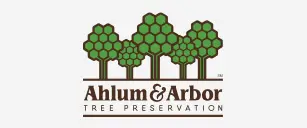Trees are a valuable part of any large property. They add beauty, provide shade, and affect property value. Asking “Are my trees safe?” is a logical question for any property owner.
Even the healthiest-looking trees can pose serious safety risks when issues go undetected, however. For property owners in Ohio, especially those managing large estates, campuses, or commercial spaces, understanding how to spot potential hazards is key to protecting people, buildings, and surrounding landscapes.
Many property owners assume that if a tree is still standing and full of leaves, it’s perfectly safe. Unfortunately, problems like internal decay, root failure, or structural instability aren’t always visible to the untrained eye.
Common Hidden Risks in Trees
In Ohio, there are several hidden dangers to trees to be aware of, from fungal diseases to insect problems and environmental stress.
Fungal diseases
Ohio’s humid summers and wet springs create ideal conditions for fungal diseases like anthracnose, which causes leaf blight and defoliation in maples and oaks, and verticillium wilt, which affects a wide range of hardwoods and can lead to sudden branch dieback.
Other common threats include apple scab on crabapples and oak wilt, a serious disease that can spread rapidly between trees.
To spot potential fungal diseases, look for:
- Leaf spots that are circular brown, black or yellow
- Powdery mildew that appears like a powdery coating on leaves
- Root rot in which yellowing leaves, branch die-back or mushrooms at the base may indicate
- Cankers, or sunken or swollen areas on the trunk or branches
Insect problems
Insect pests like the emerald ash borer have devastated ash populations across Ohio, and newer threats like the spotted lanternfly are starting to appear. Japanese beetles, scale insects and bagworms are also widespread, especially in ornamental and landscape trees.
To spot potential insect problems, look for:
- Scale insects, or small, round bumps on branches and leaves
- Aphids, which are tiny insects clustering on new growth
- Borers, which create small holes in the trunk and sawdust-like material
- Bagworms, which typically form small bags that hang from evergreen branches
Environmental stress
Ohio’s fluctuating weather, clay-heavy soils and increasingly extreme seasonal changes can put stress on trees, even if they appear healthy. Compacted soil, drought conditions and late frosts are all common causes of decline.
To spot potential environmental stress on your trees, look for:
- Wilting during the hottest part of the day or in late summer months
- Leaf scorch, or brown edges
- Early leaf drop
- Reduced growth
Other common hidden risks
Internal Decay
A tree may look sturdy on the outside but be rotting from within. Internal decay can weaken the tree’s core and make it more likely to fall during strong winds or heavy snow. In Ohio, fungal pathogens like Armillaria (honey fungus) and Ganoderma are common culprits.
Root Damage
Roots are a tree’s anchor, and when they’re compromised, the entire structure can become unstable. Root damage may occur during construction, trenching or even heavy mowing near the base. Poor drainage or compacted clay soils, which are common in parts of Ohio, can also suffocate roots over time. Warning signs include a sudden lean, thinning leaves or heaving soil around the base of the tree.
Cracks and Splits
Cracks in the trunk or major limbs can mean the tree is structurally unsound. This is particularly true when a tree has multiple trunks or a V-shaped fork with “included bark,” which weakens the connection between limbs. In winter, freeze-thaw cycles can widen existing splits, making Ohio trees especially vulnerable during early spring storms.
Site-Wide Risk Factors on Large Properties
While a single backyard tree is relatively easy to monitor, large properties pose a different set of challenges. A tree that might go unnoticed on a back fence line can still cause significant harm if it fails.
When surveying your large property, keep an eye out for trees in high-traffic areas. Pay special attention to trees near walkways, driveways, parking lots and building entrances. A falling limb in these areas can injure someone or damage cars and property. Even minor dieback or deadwood becomes more serious when foot traffic is involved.
Clusters of the same species may be problematic as well. On many Ohio campuses or developments, the original landscapers may have planted large groups of the same tree species. While aesthetically pleasing, this makes it easier for pests and diseases to spread quickly. For example, a row of untreated ash trees can be decimated by emerald ash borer within a few seasons.
Because of their sheer size, large properties often have irregular tree care schedules, sometimes going years without a professional inspection. This increases the likelihood of problems being missed until a limb falls or a tree uproots.
What You Can Check Yourself
While some risks require a professional diagnosis, property owners and managers can perform regular visual inspections to catch early signs of trouble. Here are four steps to help you check whether your trees are safe.
Step 1: Start with the base.
Look for mushrooms or fungal growth around the base of the trunk, as well as soil that appears lifted or cracked, especially after heavy rain. Also check for signs of burrowing animals that might undermine the root system.
Step 2: Check the trunk.
Inspect the trunk for cracks, holes, oozing sap or bark that’s peeling away. Look for pest entry points as well. Use a rubber mallet to gently tap the trunk in several places; a hollow sound can indicate internal decay.
Step 3: Examine the canopy.
The tree’s canopy should have good structure with well-spaced branches. Stand back and scan the tree’s overall shape. Is it leaning more than usual? Are branches missing leaves or appearing sparse? Look for dead limbs (“widow-makers”) that could fall in a storm. Binoculars can help spot issues in the upper canopy.
Step 4: Document changes.
Take photos of suspect areas and monitor them over time. Seasonal changes can mask tree health problems, so it’s helpful to have a record to refer to or show your arborist. If you’re still asking yourself, “Are my trees safe?” after this check, it’s time to call a certified arborist.
How a Certified Arborist Can Help
Some issues are just too complex or dangerous for a property owner to evaluate alone. In these cases, calling an ISA Certified Arborist is the best course of action.
A certified arborist focuses on maintaining the health and longevity of trees. While landscapers or a neighborhood “tree guy” may be able to handle small limb removal, an experienced arborist has extensive knowledge in the health biology and science behind trees. An arborist also has the proper certifications that ensure the knowledge and experience necessary to properly take care of your trees.
Two key certifications to look for include ISA Certified Arborist and Board Certified Master Arborist.
An ISA Certified Arborist has:
- At least three years of experience
- Passed a comprehensive exam on tree care
- Demonstrated a solid understanding of tree growth and maintenance
A Board-Certified Master Arborist has:
- Typically over eight years of experience
- An advanced and extensive knowledge of tree biology and care
- The highest level of certification in the field
Tree removal companies can cut down trees and remove them, but certified arborists put together management plans to keep trees healthy and happy – or put together a plan to improve the health of trees so that they can remain a part of your landscape.
Maintaining large properties can be overwhelming, especially when hidden tree hazards can develop silently over time. A certified arborist can help you spot these potential issues early – before they become dangerous or lead to costly removals – preserving the health and beauty of your trees for years to come and answering the question, “Are my trees safe”?
Contact us for an appointment.


